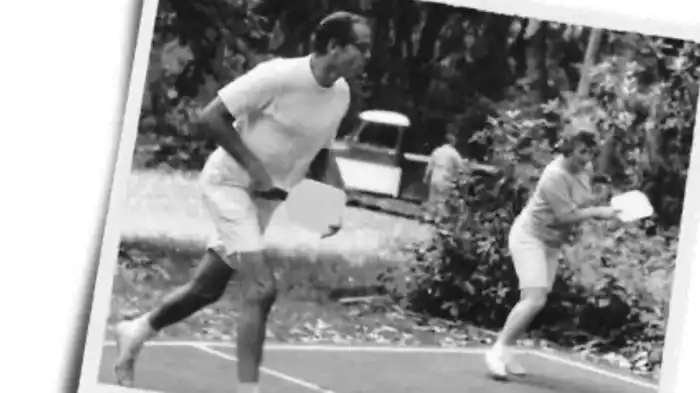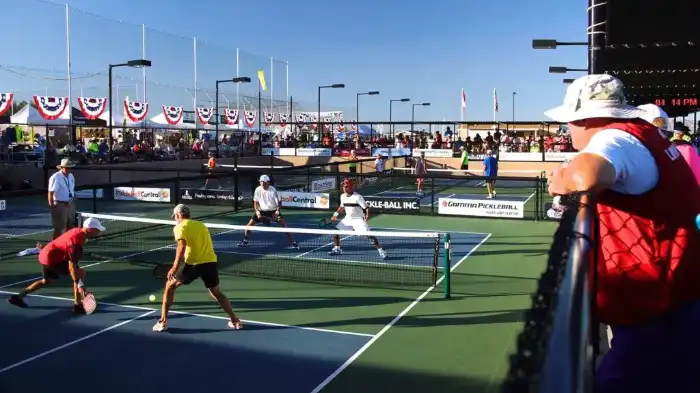Pickleball, a well-loved paddle sport blending elements of tennis, badminton, and table tennis, has steadily gained widespread acclaim. But have you ever pondered the intriguing history concealed within its distinctive name? In this blog post, we are going to discuss about the history of pickleball name and how this game expanded and evolved.
Information on the History of Pickleball Name
The story of pickleball dates back to the summer of 1965 when Joel Pritchard, a congressman from Washington State, and his friend Bill Bell were looking for a game to entertain their families during a lazy afternoon. With limited equipment and space, they decided to create a game that would be easy for everyone to play. Pritchard’s dog, Pickles, even played a role in the game’s inception, providing inspiration for the name.

As the game gained traction, its inventors began to search for a suitable name. The commonly accepted narrative is that Pickleball got its moniker from the Pritchard family’s cocker spaniel named Pickles. According to Joan Pritchard, Joel Pritchard’s wife, the name “Pickleball” emerged because the dog enjoyed running off with the balls during play. However, this story is only a part of the overall history.
This led Pritchard’s family to jokingly refer to the game as “pickle’s ball,” eventually shortened to pickleball. Although Pickles did not directly influence the rules or mechanics of the game, his name became forever associated with this new and exciting paddle sport.
How the Pickleball Was Expanded and Evolved?
After its humble beginnings, pickleball quickly gained popularity among Pritchard’s friends and neighbors. The sport spread within their community, and soon other local communities noticed its appeal. Pritchard and Bell began to organize demonstration games, introducing more people to the vibrant sport.
Introduction to the Larger Audience
In 1972, Barney McCallum, another key figure in pickleball’s history, visited Pritchard and Bell’s neighborhood. Captivated by the sport, he has helped to refine the rules and equipment, paving the way for pickleball’s growth. McCallum’s involvement led to the development of standardized pickleball paddles and balls, bringing legitimacy to the sport.
Pickleball’s Rise to National Recognition
Throughout the 1970s and 1980s, pickleball gained momentum, primarily through grassroots efforts. Tournaments started popping up across the United States, attracting players of all skill levels. In 1984, the USA Pickleball Association (USAPA) was formed to provide structure and organization to the ever-growing pickleball community.
Recognition as a Competitive Sport
As the USAPA worked tirelessly to promote the sport, pickleball began to gain recognition as a legitimate competitive sport. The organization established official rules and regulations, ensuring fair play and consistent standards across tournaments. As a result, pickleball’s popularity soared, attracting players from all generations.

Global Reach and Olympic Aspirations
Pickleball’s popularity extends far beyond the United States, with a growing global presence in countries like Canada, Australia, and Spain. Enthusiasts worldwide have fostered vibrant pickleball communities, organizing tournaments and events. Many in the pickleball community aspire to see the sport featured in the Olympic Games, recognizing its dynamic blend of agility, strategy, and athleticism, which could solidify its position in the realm of sports.
Frequently Asked Questions
Major milestones include the sport’s inception in 1965, the refinement of rules and equipment in 1972, the formation of the USAPA in 1984, and its growing global reach and aspirations for Olympic recognition.
Key figures in the early history of pickleball’s name were Joel Pritchard, a Washington State congressman, and his friend Bill Bell, who co-invented the sport in 1965. While creating the game, they playfully attributed its name to Pritchard’s dog, Pickles, who occasionally ran off with the balls. In 1972, Barney McCallum joined the community and helped to refine the pickleball’s rules and equipment. McCallum’s involvement and dedication to promoting the sport contributed significantly to its early expansion. These individuals played pivotal roles in the initial development of pickleball, which has since become a widely popular paddle sport.
Throughout the 1970s and 1980s, pickleball gained momentum through grassroots efforts, with tournaments spreading across the United States. The establishment of the USA Pickleball Association (USAPA) in 1984 further legitimized the sport, providing official rules and regulations.
The sport gained recognition when Barney McCallum visited Pritchard and Bell’s neighborhood in 1972. His involvement helped refine the game and contributed to its expansion.
Conclusion
In conclusion, the history of pickleball name intertwines the playful influence of a pet and the creative ingenuity of its founders. The sport’s humble beginnings and subsequent evolution showcase the collaborative efforts of passionate enthusiasts and the establishment of standardized regulations. Pickleball’s journey from local communities to national recognition, and its expanding global reach, reflect its universal appeal and growing popularity. As enthusiasts set their sights on the Olympic Games, pickleball continues to captivate players worldwide, solidifying its position as a dynamic and competitive sport with a rich and fascinating history.

